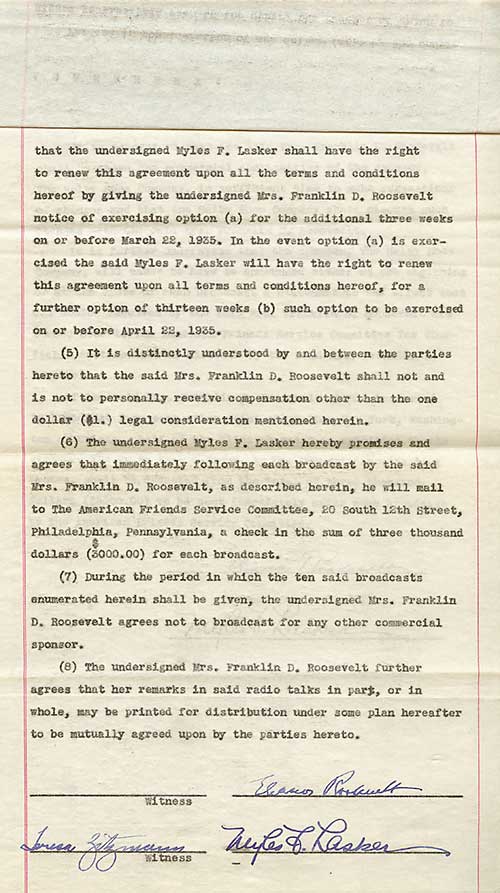SOLD Eleanor Roosevelt’s Original Contract For Her 1935 Series of Radio Talks

She donated all of the proceeds to benefit the poor in the coalfields.
Mrs. Roosevelt’s association with the American Friends Service Committee (AFSC) began before Franklin Roosevelt’s inauguration in March 1933. The AFSC had started a childfeeding program in the coal mining regions of Pennsylvania and West Virginia in 1931.
The Roosevelts became acquainted with the AFSC’s increasing work there and in late 1932,...
Mrs. Roosevelt’s association with the American Friends Service Committee (AFSC) began before Franklin Roosevelt’s inauguration in March 1933. The AFSC had started a childfeeding program in the coal mining regions of Pennsylvania and West Virginia in 1931.
The Roosevelts became acquainted with the AFSC’s increasing work there and in late 1932, Clarence Pickett, then executive secretary of the Service Committee, was invited to be an overnight guest at the Roosevelt home in Hyde Park to speak about the plight of miners, the conditions under which their families lived, and the AFSC’s efforts in providing aid and vocational re-education. As First Lady, she went in person to see the conditions in mining areas, and supported its people and the AFSC’s work amongst them throughout the Depression. Photographs of Mrs. Roosevelt with miners and their families are often seen in books about her, as her efforts for the poor there have come to symbolize her overall work throughout society to improve people’s lives.
In early 1935 Mrs. Roosevelt was approached about doing a series of radio broadcasts about a subject dear to her heart women’s rights. She agreed to do so, and at the same time donated all of the proceeds she would receive to the AFSC for its work in the coal fields. Here is her original contract for the broadcasts.
Document Signed twice as First Lady, three pages in a legal blue binder, January or February 1935. In the contract, Mrs. Roosevelt agrees to make ten radio broadcasts arranged by journalist Myles Lasker, “the first broadcast to be on February 15, 1935, Friday evening at 8:00 to 8:15 from a place to be mutually agreed upon…The programs are to be of fifteen minutes duration during which program the undersigned Mrs. Franklin D. Roosevelt agrees to speak for approximately nine minutes on the topic of ‘Women of Today.’…The programs are to be over the facilities of the Columbia Broadcasting Company…” Recognizing that sponsors have concerns about content, and wanting to be cooperative without being controlled, the First Lady was willing to allow the sponsor, Shelby Shoe Co., “to see the talks enough in advance to allow whatever suggestions necessary.” Thus, Shelby could make suggestions to Mrs. Roosevelt, but not demands. She wanted to be sure that everyone realized that she was not doing the broadcasts for money, and that no negative spin could be put on her motivations by her husband’s political foes; she thus specifically stipulated “It is distinctly understood…that the said Mrs. Franklin D. Roosevelt shall not and is not to personally receive compensation other than the one dollar legal consideration mentioned herein.” However, the promoter Lasker and sponsors were not to enjoy a free ride either. Lasker promised that “immediately”after each broadcast,“he will mail to the American Friends Service Committee…a check in the sum of $3,000.” Lasker was also granted an option for an additional thirteen broadcasts on the same terms. On the third page is a separately signed addendum in which the First Lady obtained the consent of the sponsor to allow her some say over the timing of commercials, and stipulated that an announcement be made at the start or close of the program saying that her proceeds were being donated to charity.
Eleanor Roosevelt gave the radio talks agreed to in this contract and they proved notable. In one made in April 1935, she said, "When I found that I could earn a certain amount of money on the radio, I realized that the American Friends Service Committee was doing work of the type which I was most interested in." And she, as ever, proved true to her values.

Frame, Display, Preserve
Each frame is custom constructed, using only proper museum archival materials. This includes:The finest frames, tailored to match the document you have chosen. These can period style, antiqued, gilded, wood, etc. Fabric mats, including silk and satin, as well as museum mat board with hand painted bevels. Attachment of the document to the matting to ensure its protection. This "hinging" is done according to archival standards. Protective "glass," or Tru Vue Optium Acrylic glazing, which is shatter resistant, 99% UV protective, and anti-reflective. You benefit from our decades of experience in designing and creating beautiful, compelling, and protective framed historical documents.
Learn more about our Framing Services







































































































